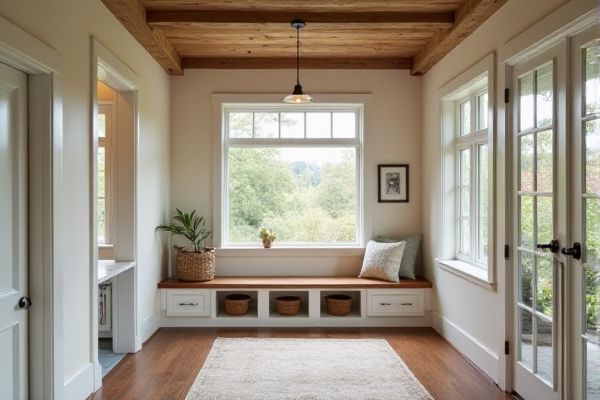
Choosing between a mudroom drop ceiling and exposed beams affects both style and functionality, with drop ceilings offering easy access to plumbing and wiring while exposed beams provide a rustic, spacious feel. Explore the advantages and design considerations to determine which option best suits Your home's needs and aesthetic preferences. Read on to discover key insights for your mudroom ceiling choice.
Table of Comparison
| Feature | Mudroom Drop Ceiling | Exposed Beams |
|---|---|---|
| Appearance | Clean, modern, uniform surface | Rustic, architectural, adds character |
| Installation | Requires framing and panels, easier to conceal utilities | May involve structural work, shows natural elements |
| Maintenance | Easy to clean and replace individual tiles | Requires dusting, potential for upkeep of wood finish |
| Cost | Moderate to low depending on materials | Higher due to materials and labor |
| Utility Access | Allows easy access to wiring and plumbing | Limited access, may require removal or modification |
| Ceiling Height | Reduces height slightly | Maintains or accentuates height |
| Sound Insulation | Better sound dampening | Less sound insulation |
Introduction to Mudroom Ceiling Options
Mudroom ceiling options include drop ceilings and exposed beams, each offering distinct aesthetic and functional benefits. Drop ceilings provide easy access to plumbing and electrical systems while enhancing insulation and soundproofing. Exposed beams create a rustic, open feel that highlights architectural character and maximizes vertical space.
Overview: Drop Ceiling vs Exposed Beams
A mudroom drop ceiling offers a clean, uniform look with easy access to plumbing and electrical systems while providing sound insulation and concealing ductwork. Exposed beams create an open, rustic aesthetic that enhances architectural character and visual height but may require more maintenance and limit access to utilities. Choosing between a drop ceiling and exposed beams depends on desired style, functionality, and ease of maintenance in the mudroom space.
Aesthetic Appeal: Style Differences
Mudroom drop ceilings offer a clean, uniform aesthetic that complements modern and minimalist interior designs, enhancing your space with a sleek, polished look. Exposed beams provide a rustic, architectural charm, emphasizing natural textures and adding character through visible wood grain and structural elements. Choosing between these styles depends on whether you prefer the streamlined elegance of drop ceilings or the warm, inviting ambiance created by exposed beams.
Functional Considerations for Mudrooms
Mudroom drop ceilings offer practical benefits by concealing ductwork, wiring, and insulation, creating a clean and organized space that is easy to maintain. Exposed beams in mudrooms enhance aesthetic appeal and provide structural visibility but may complicate installation of lighting fixtures and insulation management. Prioritizing moisture resistance and ease of cleaning are essential functional considerations when choosing between drop ceilings and exposed beams in mudroom design.
Installation Process: Drop Ceiling vs Exposed Beams
Installing a mudroom drop ceiling typically involves framing a grid system and fitting lightweight ceiling tiles, offering easier access to plumbing and wiring above. Exposed beam installation requires securing heavy structural elements directly to joists, demanding precise measurements and professional expertise for a stable finish. Choosing between drop ceilings and exposed beams affects your installation time, complexity, and maintenance needs in your mudroom space.
Maintenance and Durability
Mudroom drop ceilings offer easy access to plumbing and wiring for maintenance, making repairs simpler and less invasive. Exposed beams, while visually appealing and durable, can accumulate dust and require regular cleaning to maintain their appearance. Your choice depends on balancing the convenience of upkeep with the long-term sturdiness and aesthetic preference of the space.
Cost Comparison
Mudroom drop ceilings typically cost less upfront, averaging between $2 to $6 per square foot for materials and installation, offering a budget-friendly option that conceals wiring and ductwork. Exposed beams, however, can increase expenses due to the need for structural assessment, custom finishes, or reclaimed wood, with prices ranging from $10 to $25 per linear foot depending on material quality and craftsmanship. Your choice hinges on balancing initial investment with aesthetic preference and long-term maintenance costs.
Energy Efficiency and Insulation
A mudroom with a drop ceiling offers enhanced energy efficiency by allowing easy installation of insulation above the ceiling panels, reducing heat loss and improving temperature control. Exposed beams, while aesthetically appealing, often lack integrated insulation options, leading to potential drafts and increased energy consumption. Properly insulated drop ceilings contribute to lower utility bills and create a more comfortable indoor environment in transitional spaces like mudrooms.
Resale Value and Home Appeal
Mudroom drop ceilings offer a clean, finished look that can boost your home's resale value by appealing to buyers seeking practical and modern spaces. Exposed beams create a rustic, architectural charm that enhances home appeal by adding character and a sense of spaciousness. Choosing between the two depends on the desired aesthetic and target market, with drop ceilings favoring contemporary buyers and exposed beams attracting those who appreciate unique design elements.
Choosing the Right Ceiling for Your Mudroom
Selecting the ideal ceiling for your mudroom involves weighing the benefits of a drop ceiling against exposed beams. Drop ceilings offer easy access to plumbing and wiring, providing a clean, modern finish that's ideal for maintenance and lighting integration. Exposed beams create a rustic, spacious feel, showcasing architectural details that add character and enhance the room's aesthetic appeal.
 homyna.com
homyna.com